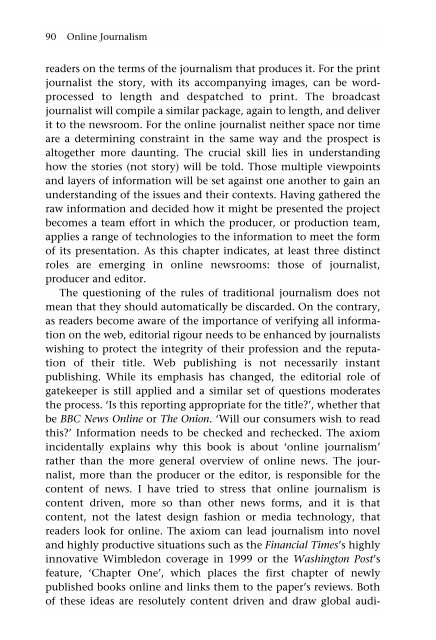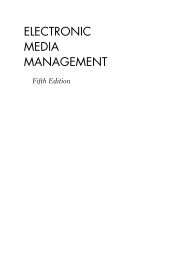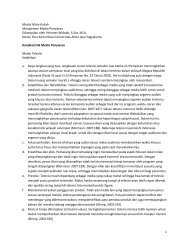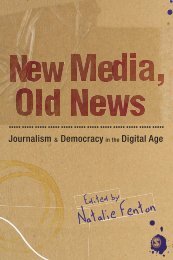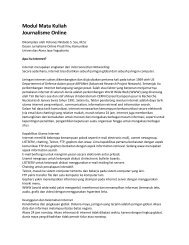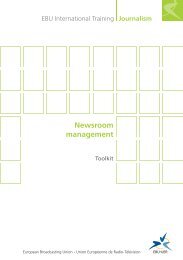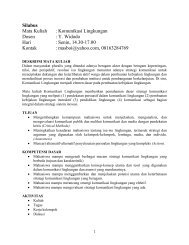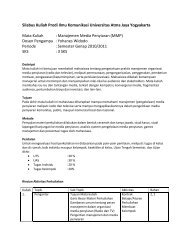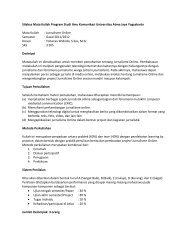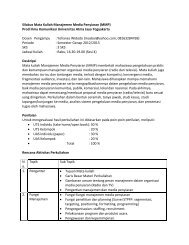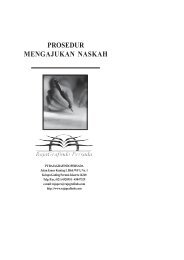Online Journalism - Ayo Menulis FISIP UAJY
Online Journalism - Ayo Menulis FISIP UAJY
Online Journalism - Ayo Menulis FISIP UAJY
You also want an ePaper? Increase the reach of your titles
YUMPU automatically turns print PDFs into web optimized ePapers that Google loves.
90 <strong>Online</strong> <strong>Journalism</strong><br />
readers on the terms of the journalism that produces it. For the print<br />
journalist the story, with its accompanying images, can be wordprocessed<br />
to length and despatched to print. The broadcast<br />
journalist will compile a similar package, again to length, and deliver<br />
it to the newsroom. For the online journalist neither space nor time<br />
are a determining constraint in the same way and the prospect is<br />
altogether more daunting. The crucial skill lies in understanding<br />
how the stories (not story) will be told. Those multiple viewpoints<br />
and layers of information will be set against one another to gain an<br />
understanding of the issues and their contexts. Having gathered the<br />
raw information and decided how it might be presented the project<br />
becomes a team effort in which the producer, or production team,<br />
applies a range of technologies to the information to meet the form<br />
of its presentation. As this chapter indicates, at least three distinct<br />
roles are emerging in online newsrooms: those of journalist,<br />
producer and editor.<br />
The questioning of the rules of traditional journalism does not<br />
mean that they should automatically be discarded. On the contrary,<br />
as readers become aware of the importance of verifying all information<br />
on the web, editorial rigour needs to be enhanced by journalists<br />
wishing to protect the integrity of their profession and the reputation<br />
of their title. Web publishing is not necessarily instant<br />
publishing. While its emphasis has changed, the editorial role of<br />
gatekeeper is still applied and a similar set of questions moderates<br />
the process. ‘Is this reporting appropriate for the title?’, whether that<br />
be BBC News <strong>Online</strong> or The Onion. ‘Will our consumers wish to read<br />
this?’ Information needs to be checked and rechecked. The axiom<br />
incidentally explains why this book is about ‘online journalism’<br />
rather than the more general overview of online news. The journalist,<br />
more than the producer or the editor, is responsible for the<br />
content of news. I have tried to stress that online journalism is<br />
content driven, more so than other news forms, and it is that<br />
content, not the latest design fashion or media technology, that<br />
readers look for online. The axiom can lead journalism into novel<br />
and highly productive situations such as the Financial Times’s highly<br />
innovative Wimbledon coverage in 1999 or the Washington Post’s<br />
feature, ‘Chapter One’, which places the first chapter of newly<br />
published books online and links them to the paper’s reviews. Both<br />
of these ideas are resolutely content driven and draw global audi-


